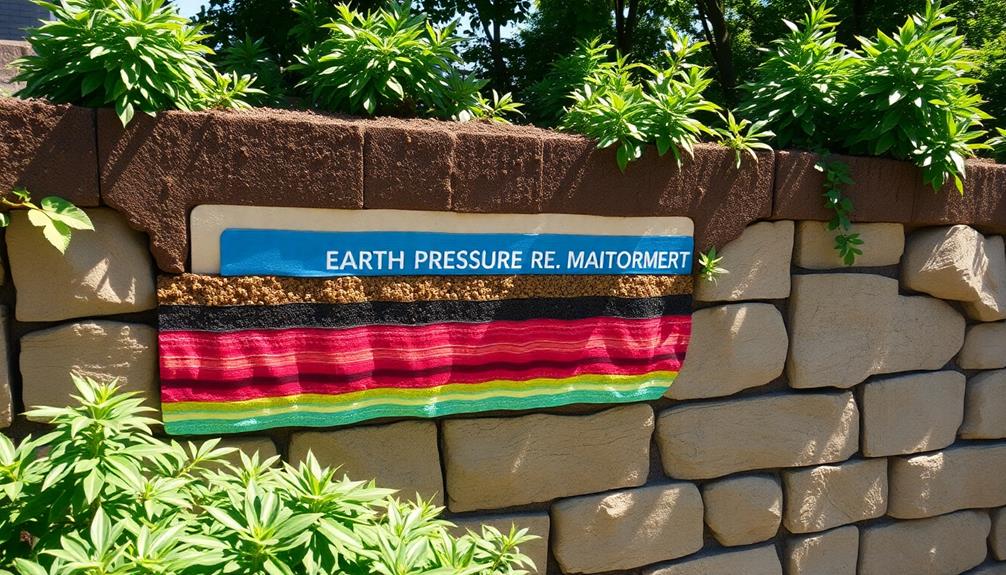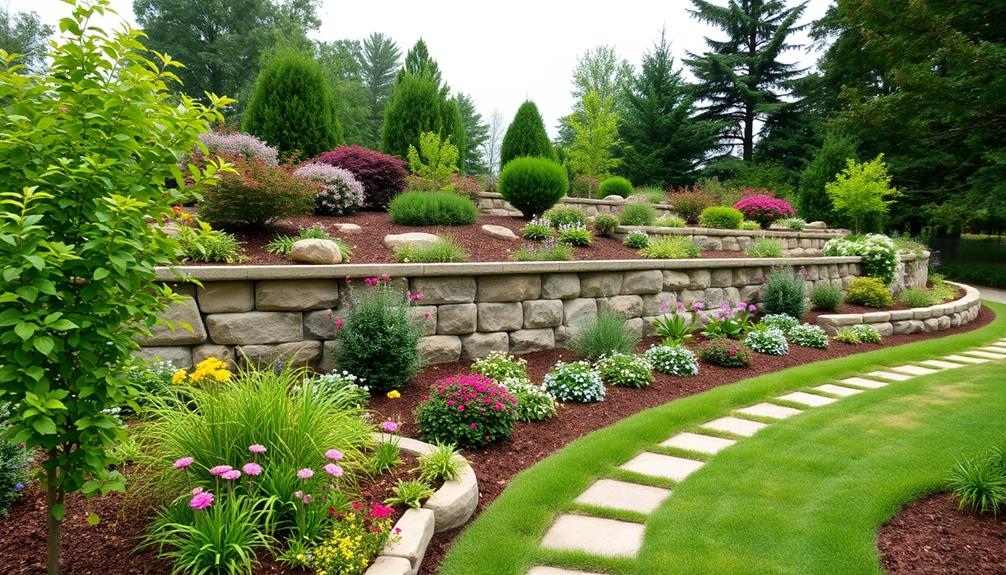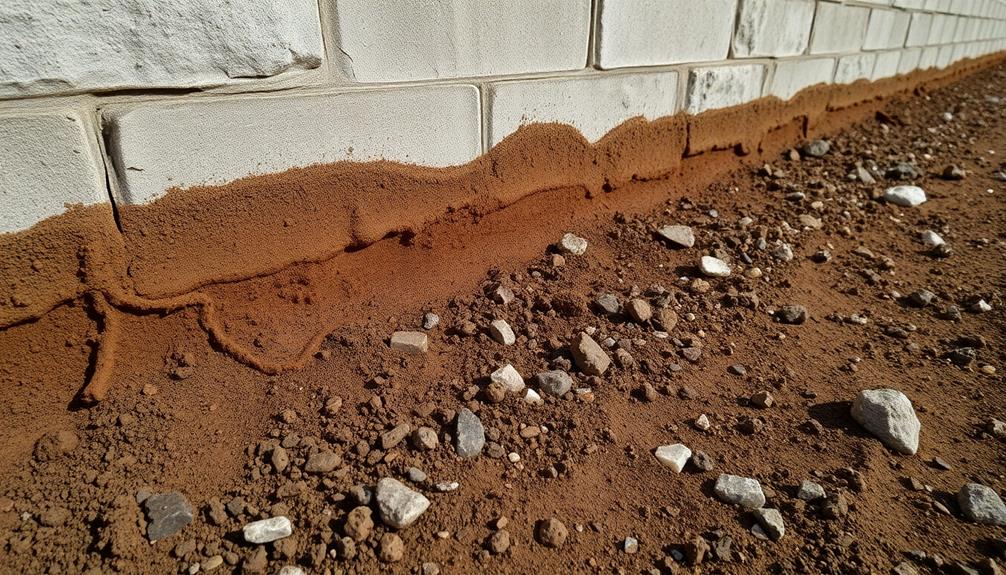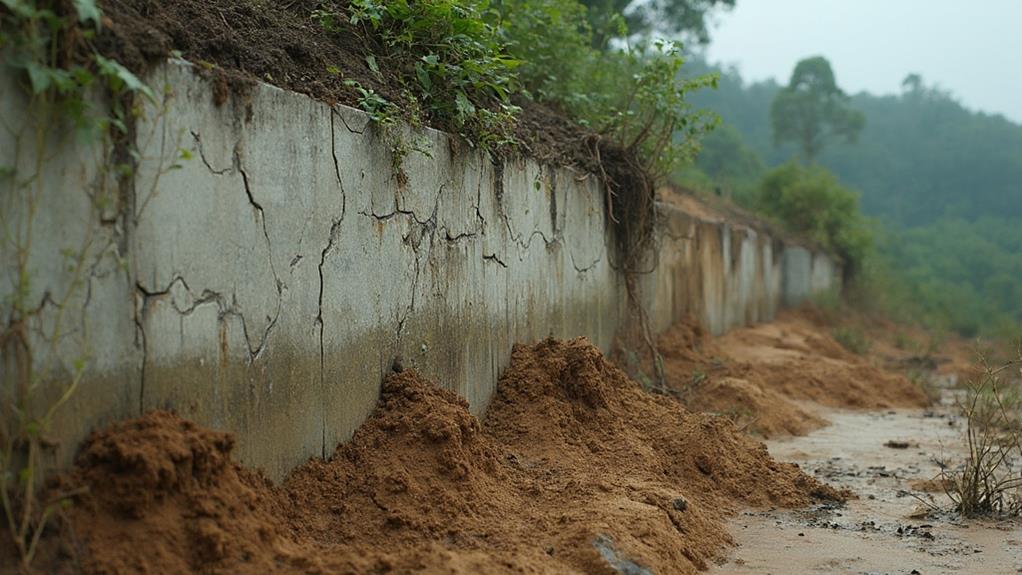Identifying common issues in retaining walls involves examining their structural integrity, drainage systems, material condition, and surrounding vegetation. Key indicators of structural problems include tilting, bulging, cracks, and uneven settling, often resulting from improper design, insufficient reinforcement, or adverse environmental factors like freeze-thaw cycles. Drainage complications, such as hydrostatic pressure due to inadequate drainage systems or clogged pipes, considerably contribute to wall failure. Material deterioration manifests through cracking, spalling, or rust, while unmanaged vegetation may exacerbate structural weaknesses. Addressing these aspects helps maintain the wall's longevity and safety, with further insights available to enhance your understanding and solutions.
Table of Contents
ToggleWalls Contractor Highlights
- Inspect for cracks, bulging, or tilting, which indicate structural integrity issues.
- Check for water pooling or erosion to identify drainage problems.
- Look for signs of material deterioration, such as spalling or corrosion.
- Examine vegetation for root intrusion or overgrowth affecting the wall.
- Assess construction flaws like improper alignment or inadequate reinforcement.
Definition of Retaining Walls

Retaining walls are structural systems designed to hold back soil and prevent erosion, serving both functional and aesthetic purposes in landscaping and construction. They can be constructed from a variety of materials, including concrete, stone, timber, and reinforced earth, each offering distinct advantages and considerations depending on the specific needs of the project.
For instance, boulder retaining walls make a powerful statement and complement various landscape styles. The design and construction of retaining walls require careful planning and engineering to guarantee stability and durability, addressing factors such as soil type, load-bearing capacity, and environmental conditions.
Purpose and Functionality
A retaining wall's primary purpose is to hold back soil or rock from a building, structure, or general area where the land elevation changes. This fundamental function is essential in preventing erosion, managing water runoff, and stabilizing sloped landscapes. Serving as a protective barrier, retaining walls guarantee that the integrity of the surrounding environment is maintained, offering both practical and aesthetic benefits to a property.
Retaining walls are indispensable for various reasons:
- Erosion Control: They prevent soil erosion by maintaining the landscape's stability, particularly on inclines.
- Water Management: Retaining walls can effectively channel water away from structures, reducing the risk of flooding and water damage.
- Slope Stabilization: By supporting steep slopes, they prevent landslides and soil movement that could jeopardize safety.
- Space Utilization: They create usable land in otherwise challenging terrains, enhancing the functionality of outdoor spaces.
- Aesthetic Enhancement: Retaining walls can be designed to complement the existing landscape, adding visual appeal to properties.
When designed and constructed correctly, retaining walls become an integral part of a property's landscape architecture, contributing to the community's sense of place and belonging by ensuring safety and enhancing the visual landscape.
Types and Materials
When considering the construction of retaining walls, it is essential to understand the various types and materials available, as each offers distinct advantages tailored to specific needs. Retaining walls serve the essential purpose of holding back soil and managing land elevation. The choice of type and material can profoundly impact both functionality and longevity.
Common types include gravity walls, which rely on their mass to resist pressure; cantilever walls, using a slender arm extending from a base slab to provide support; and anchored walls, incorporating cables or other stays for additional stability.
Materials play a critical role in the wall's performance, durability, and aesthetic appeal. Concrete is a popular choice due to its strength and versatility, often used in precast blocks or poured forms. Stone provides a natural appearance and excellent durability, while timber lends a rustic charm but may require more maintenance. Steel and gabion walls, composed of wire mesh filled with rocks, offer industrial strength and are ideal for specific conditions.
The selection of type and material should align with the environmental conditions, site-specific challenges, and desired visual outcomes, ensuring the retaining wall not only functions effectively but also integrates seamlessly with its surroundings.
Design and Construction
The design and construction of retaining walls require a thorough understanding of both engineering principles and environmental considerations. These structures serve a critical role in stabilizing soil, preventing erosion, and creating usable land in areas with challenging topography. To guarantee their effectiveness and longevity, several key factors must be meticulously planned and executed.
- Soil Analysis: Understanding the type and stability of the soil is indispensable for selecting the appropriate design and materials.
- Drainage Systems: Proper drainage systems must be integrated to prevent water accumulation, which can lead to wall failure.
- Structural Load: The wall must be designed to withstand the anticipated load and pressure from the retained soil and any additional forces.
- Material Selection: Choosing the right materials, whether concrete, stone, or timber, is essential for durability and aesthetic harmony with the surroundings.
- Compliance with Regulations: Adhering to local building codes and regulations ensures safety and legal compliance.
Incorporating these elements into the design and construction process is essential for the success of retaining walls. By doing so, communities can create landscapes that are not only functional and safe but also blend seamlessly into their natural surroundings, fostering a sense of belonging and cohesion.
Benefits

Retaining walls offer significant advantages by enhancing the structural integrity of a property, as they provide indispensable support to prevent soil erosion and landslides.
These structures not only contribute to increased property value by creating usable space and adding a sense of permanence, but they also improve aesthetic appeal by offering opportunities for landscaping and creative design.
Additionally, retaining walls guarantee proper drainage and reinforcement, which plays a crucial role in optimizing erosion control. This focus on efficient erosion control guarantees the long-term stability and safety of the surrounding environment, making them a valuable investment for property owners.
Enhanced Structural Integrity
One of the key benefits of enhanced structural integrity in retaining walls is the significant improvement in their ability to withstand environmental pressures and loads. This resilience is indispensable for properties facing challenging terrains or adverse weather conditions.
Enhanced structural integrity ensures that retaining walls maintain their form and function over time, reducing maintenance needs and potential failures. Such robustness fosters a sense of security and reliability among homeowners and property managers, creating a strong foundation for community and peace of mind.
The advantages of improved structural integrity in retaining walls include:
- Increased Durability: Withstanding harsh environmental factors for longer periods.
- Reduced Maintenance: Lower frequency of repairs and replacements, saving time and resources.
- Enhanced Safety: Minimizing the risk of structural failure, thereby safeguarding people and property.
- Sustainability: Utilizing materials and designs that contribute to long-term environmental stewardship.
- Improved Aesthetics: Maintaining wall appearance and structural form over time, enhancing visual appeal.
These benefits collectively contribute to a more sustainable and cohesive community environment, where individuals can feel confident in the enduring strength and reliability of their surroundings. Such enhanced structural integrity in retaining walls not only supports physical stability but also strengthens the communal fabric by fostering trust and assurance.
Increased Property Value
Building on the enhanced structural integrity of retaining walls, property owners can also experience a notable increase in property value. Retaining walls not only serve as protective barriers against soil erosion and instability but also signify a well-maintained property. This structural investment speaks volumes about the homeowner's commitment to safeguarding their land, which can be particularly appealing to potential buyers. The assurance of a stable landscape is a compelling selling point, as it minimizes future maintenance concerns and potential repair costs for new owners.
Moreover, retaining walls can expand usable outdoor space, effectively transforming sloped or uneven terrain into functional areas for gardens, patios, or recreational areas. This additional space can drastically boost a property's appeal and utility, providing potential buyers with the vision of enhanced living environments. The ability to maximize lot usage without compromising the structural integrity of the property is an attractive prospect for many.
In the competitive real estate market, properties with robust, well-constructed retaining walls often stand out. They symbolize a blend of practicality and foresight, appealing to the desire for a secure and valuable investment. Consequently, this can lead to higher offers and faster sales, enhancing the property's overall market value.
Improved Aesthetic Appeal
Enhancing the visual appeal of a property, retaining walls serve as more than just functional structures; they are integral design elements that can elevate the overall aesthetic of outdoor spaces. These walls can transform an ordinary landscape into an extraordinary one, providing not only structural support but also artistic expression.
By incorporating diverse materials, textures, and colors, retaining walls can seamlessly blend into their surroundings or stand out as a focal point. This adaptability guarantees that they complement various architectural styles and personal preferences, fostering a sense of belonging within the community.
Consider the following aesthetic enhancements when planning or evaluating a retaining wall:
- Material Variety: Options such as stone, brick, or wood, each offering a unique visual and tactile experience.
- Color Coordination: Harmonizing wall colors with existing structures to create a cohesive look.
- Texture Integration: Utilizing smooth or rough surfaces to add depth and interest.
- Floral Additions: Incorporating planters or vertical gardens to soften hard lines and bring life to the space.
- Lighting Features: Installing ambient lighting to highlight the wall's design, enhancing nighttime aesthetics.
Erosion Control Efficiency
While retaining walls are often appreciated for their aesthetic contributions, their role in erosion control is equally essential, offering significant benefits to landscape stability. These structures serve as a formidable barrier to soil displacement, effectively managing runoff by redirecting water flow and minimizing soil erosion. This function is particularly indispensable in sloped areas, where the risk of land degradation is substantial.
By mitigating erosion, retaining walls preserve the integrity of the landscape, preventing the loss of valuable topsoil, which is fundamental for vegetation growth and ecological balance.
Moreover, the installation of a well-designed retaining wall can enhance the overall drainage system of a property. By controlling the direction and velocity of water movement, these walls help prevent waterlogging and reduce the likelihood of flooding. This, in turn, contributes to the long-term sustainability of the environment by maintaining consistent soil moisture levels, which are critical for plant health.
For communities, the benefits are tangible; reduced erosion means lower maintenance costs and a safer, more stable environment. Retaining walls thereby play a pivotal role in fostering a sense of security and belonging, ensuring that landscapes remain both beautiful and functional for future generations.
Soil Erosion Prevention

Addressing soil erosion is pivotal in maintaining the structural integrity of retaining walls, and this can be effectively managed through several key strategies. Vegetation not only enhances stability by anchoring the soil with its roots but also adds aesthetic value to the landscape. Meanwhile, a well-designed drainage system and the use of geotextile fabrics are essential in preventing water accumulation and soil displacement, as summarized in the table below.
| Strategy | Benefit |
|---|---|
| Vegetation for Stability | Anchors soil, prevents erosion |
| Drainage System Design | Reduces water accumulation |
| Geotextile Fabric Benefits | Enhances soil structure |
| Aesthetic Value | Improves landscape appearance |
Vegetation for Stability
Integrating vegetation into the design of retaining walls plays a pivotal role in enhancing their stability and preventing soil erosion. This natural approach not only strengthens the wall structure but also fosters an environment that promotes ecological balance and aesthetic appeal. By selecting the right vegetation, the retention wall can considerably benefit from root systems that interlock with the soil, anchoring it firmly in place. This method serves as a sustainable solution, reducing the reliance on artificial materials while contributing to the overall health of the ecosystem.
Key considerations for implementing vegetation in retaining wall design include:
- Root Depth and Strength: Choosing plants with deep and robust root systems that can effectively bind soil.
- Drought Tolerance: Selecting species that can withstand periods of low rainfall, minimizing maintenance efforts.
- Local Climate Compatibility: Ensuring that chosen plants are suited to the local environmental conditions to thrive naturally.
- Growth Rate: Opting for species that establish quickly to provide immediate soil stability.
- Biodiversity: Incorporating a variety of plant species to enhance ecological resilience and visual diversity.
Drainage System Design
A well-designed drainage system is fundamental to preventing soil erosion in retaining walls. By effectively managing water flow, these systems mitigate the risk of hydrostatic pressure buildup, which can compromise structural integrity. The primary objective is to direct water away from the wall, ensuring that the soil remains stable and the wall's longevity is preserved. This is achieved through a combination of various drainage components such as weep holes, perforated pipes, and gravel backfill, each playing an essential role in facilitating efficient water dispersion.
Incorporating a thorough drainage strategy into the retaining wall design is indispensable for communities seeking to maintain harmonious landscapes. Weep holes, strategically placed at the base of the wall, allow water to escape, reducing pressure against the structure. Perforated pipes, often installed behind the wall, collect and channel excess water away, further relieving stress on the wall. Gravel backfill, meanwhile, ensures prompt drainage and prevents soil saturation, thereby reducing erosion risks.
Geotextile Fabric Benefits
Geotextile fabric serves as a critical component in soil erosion prevention for retaining walls. Its application is essential in maintaining the stability and longevity of these structures by effectively managing water and soil interactions. By acting as a barrier, geotextile fabric mitigates the risk of soil erosion, which is a prevalent issue in retaining wall systems. This fabric not only offers a durable solution but also fosters an environment of reliability and safety, allowing communities to flourish in their shared spaces.
Key benefits of incorporating geotextile fabric include:
- Filtration: Allows water to pass through while retaining soil particles, preventing material loss.
- Separation: Distinguishes between different soil layers, maintaining structural integrity.
- Reinforcement: Enhances the overall strength of the soil, providing additional support to retaining walls.
- Drainage: Facilitates efficient water movement, reducing hydrostatic pressure behind walls.
- Durability: Offers resistance to biological and chemical degradation, ensuring long-term performance.
Understanding and implementing these benefits can considerably contribute to the structural resilience of retaining walls. The integration of geotextile fabric into retaining wall construction aligns with the collective goal of creating sustainable and enduring environments, fostering a sense of security and belonging within the community.
Walls Contractor FAQ
What Are the Signs of Structural Damage in Retaining Walls?
Signs of structural damage in retaining walls include visible cracks, tilting or leaning, water seepage, bulging, and gaps between wall materials. Early detection and maintenance can foster community safety and preserve the longevity of shared spaces.
How Do Weather Conditions Affect Retaining Wall Stability?
Weather conditions profoundly influence retaining wall stability. Freeze-thaw cycles, heavy rainfall, and soil erosion can compromise structural integrity. Understanding these impacts fosters a sense of community responsibility in maintaining safe and effective retaining walls for shared spaces.
What Maintenance Steps Are Essential for Retaining Walls?
Regular inspections, cleaning drainage systems, ensuring proper backfill compaction, and repairing minor cracks promptly are essential maintenance steps for retaining walls. These practices foster structural longevity and community safety, promoting a shared commitment to preserving built environments.
Can Poor Drainage Lead to Retaining Wall Failure?
Indeed, inadequate drainage is a significant factor contributing to retaining wall failure. Proper drainage guarantees stability by preventing water accumulation, which can lead to hydrostatic pressure buildup, causing structural stress and potential collapse, thereby safeguarding community safety and integrity.
What Are Common Materials Used in Constructing Retaining Walls?
Retaining walls are commonly constructed using materials such as concrete, masonry blocks, stone, and timber. These materials are selected for their durability, aesthetic appeal, and ability to blend harmoniously within various landscapes, fostering a sense of unity.







